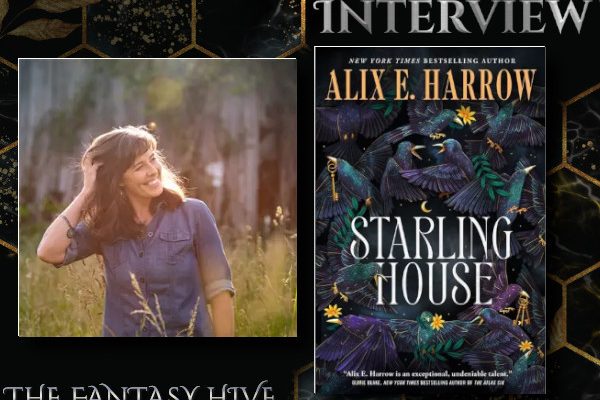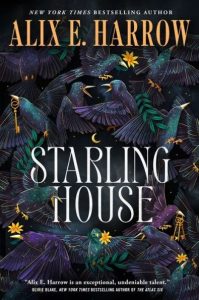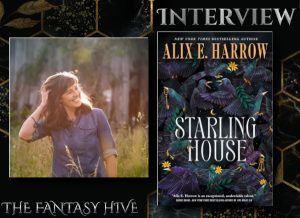Interview with Alix E Harrow (STARLING HOUSE)

Alix E. Harrow is an ex-historian with lots of opinions and excessive library fines, currently living in Kentucky with her husband and their semi-feral children. Her short fiction has been nominated for the Hugo, Nebula and Locus awards. Her full-length novels include The Ten Thousand Doors of January and The Once and Future Witches and Starling House.
Welcome back to the Hive, Alix. Firstly congratulations on your stunning new Gothic release, Starling House. Can you tell our readers a little about it?
I think my short pitch has become “southern gothic Beauty and the Beast,” but I also like to say it’s Howl’s Moving Castle but it’s in Kentucky and there’s swear words and sex.
More seriously, it’s a dark contemporary fantasy set in rural western Kentucky, roughly where I grew up, which follows a mean girl as she gets sucked into the mysteries and histories of the local haunted house.
Starling House is somewhat darker than your previous work. What initially drew you to the Gothic genre?
I’ve always loved a good gothic, honestly–I’m a very messy reader. It’s such a shapeshifting genre, from high brow to low brow and back again, from England to the American South. But what it does really well–what it’s built to do, I feel–is interrogate the familiar. To look at things that are supposed to be good and wholesome–wives, mothers, small towns, families, old houses, yellow wallpaper–and reveal their monstrous underbellies.
Which made it the only genre that could hold all the different ways I feel about Kentucky, where I’m from.
 The atmosphere within Starling House is perfectly unsettling and mysterious. Did you create a mood board to help set this atmosphere? How did you get yourself in that frame of mind?
The atmosphere within Starling House is perfectly unsettling and mysterious. Did you create a mood board to help set this atmosphere? How did you get yourself in that frame of mind?
Of course! I hate that I’m a Pinterest girlie, but I am, unfortunately, a Pinterest girlie. I actually had a lot of Rovina Cai’s art on that board, especially her illustrations for the Folio Society Wuthering Heights. It remains a highlight of my life/career that she ended up illustrating Starling House.
How do you think you would fare spending a night alone in Starling House?
Oh, we’d be buddies. My husband and I bought and fixed up an abandoned house in Kentucky, which was neither haunted nor sentient–but things went wrong so often it felt like it was. And I still miss that house.
Let’s discuss your protagonists, Opal and Arthur. They’re disastrous and flawed – what else can you tell our readers about them?
It’s so funny–sometimes I think I’m writing the world’s most relatable, sympathetic character, and then I glance at goodreads and discover that they’re a morally grey train wreck, actually.
I think a lot about this interview I heard with George Saunders, where he said something like: ‘once there was a very graceful man’ isn’t a story. ‘Once there was a very graceful man who stumbled’–that’s a story.
It’s not a story until they stumble. Opal and Arthur are both doing their best, but they’re stumbling.
Opal is supported by a wonderful cast of characters, none of whom she seems to understand and see clearly, least of all her own brother Jasper. How much of your dynamics with your own brothers feature in the dynamic between Opal and Jasper?
I mean, to be clear: I never lived in a motel with sole responsibility for my underage brothers. I had an easy, cushy, largely idyllic childhood! But writing fiction is often about finding little kernels of genuine emotion and inflating them beyond all recognition. So, it’s true that I have two much-younger, much-smarter brothers that I’ve always felt the need to protect, interrogate, assist, parent, and annoy. It’s also true that they’ve never needed me half as much as I needed them.
Conversely, everyone has strong beliefs on what they think they know of the young man who lives in Starling House. This small town mentality is something plenty will recognise, is it one you yourself are well versed in?
I grew up on the edges of towns just like Eden. But we didn’t go to church, so we were always on the margins, at arm’s length. It’s not as lonely as you’d think–there’s always company in the margins–so I made sure to give Opal that same misfit, weirdo, outsider community.
One of our favourite aspects of all your novels is the way you explore stories within stories and how they change with every retelling. Framed narratives are a classic of the Gothic genre, but what is it about this theme that you love and keep coming back to?
Yeah, I do keep doing that, don’t I? I think it’s because I just don’t think of any story as existing in isolation. Like, every book is a product of all the books that came before it, a sort of collage of influences and iterations. We don’t produce or consume stories in isolation–our writing of them, and our reading of them, is informed by every version we’ve heard before. And I guess I just think that’s neat. And fun. It’s fun to present stories as aggregates, hemmed in by other narratives at every turn.
Starling House also explores grief, loneliness and finding a home. Were these themes something you had always planned to write about or did they emerge during the writing process?
The grief and loneliness snuck up on me a bit, but it was always going to be about home. I’m from Kentucky, and so are both sides of my family way back. But none of my books and stories, prior to this one, were set there (or if they were, they were about leaving it–a telling fantasy, it turns out). It was only when we’d decided to leave home for good–we moved to Virginia two years ago–that I knew what this book would be about: staying. Or, I guess–making a home, even when it doesn’t want you. Another telling fantasy, I suspect.
Your book within a book, Underland, was famous for its author’s incredibly unsettling illustrations of monsters. Starling House has been stunningly illustrated by Rovina Cai. What was it like working with Rovina?
Absolutely incredible. Her work is just so evocative of Golden Age children’s illustrators already–some of the line work is like a softer, more sinuous Rackham, and some of the flowing structures remind me of Elenore Abbott or Marjorie Miller.
As it’s Spooktober, tell us about a haunted house book you love. Any hidden gems?
I mean, I love all the classics–Shirley Jackson, Mark Danielewski, Toni Morrison–but I feel like not enough people talk about Catherine House. It’s technically a boarding school, but it functions as a sort of mix between fairy burrow and haunted house in a way I think is so clever. And so correct! Like, the scariest haunted houses are the ones you don’t want to leave.
What’s next for you Alix? Can we hope to return to Starling House, or is that particular chapter closed?
Oh, it’s done. I’m not a sequel person, I’m so sorry! Right now I’m working on something unannounced, but also my next full-length novel: a big sad lady knight stuck in a bad time loop. (If you’re thinking: hey that sounds sort of like that short story you wrote earlier this year, “The Six Deaths of the Saint”?? Correct).
Finally, what is the one thing you hope readers take away from your writing?
I’m going to quote that same Saunders interview again (look, he’s really smart and warm and funny, and obviously says things better than I ever could). He said–I’m paraphrasing–that being a writer is basically the same job as designing roller coasters. You’re just trying to give people a ride, and leave them with just a split second of astonishment. Then he said–and now I’m not paraphrasing: “It’s hard to make the case for the value of astonishment, but you couldn’t live a day without it.”
So I guess that’s my ambition: a moment of astonishment.
Thank you so much for joining us today!
Thank you so much for having me. It’s such a privilege to talk with such discerning, insightful readers!
Starling House is out today – and perfect for Halloween. You can order your copy on Bookshop.org

